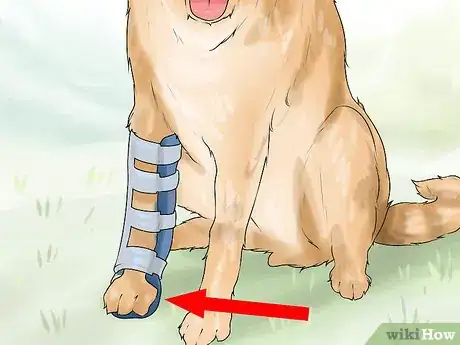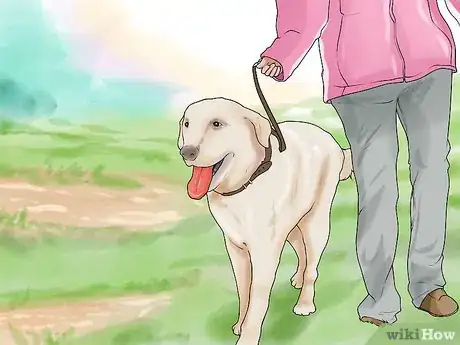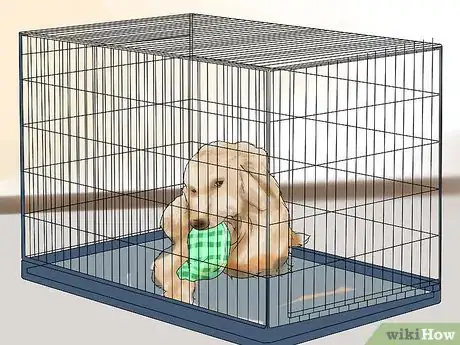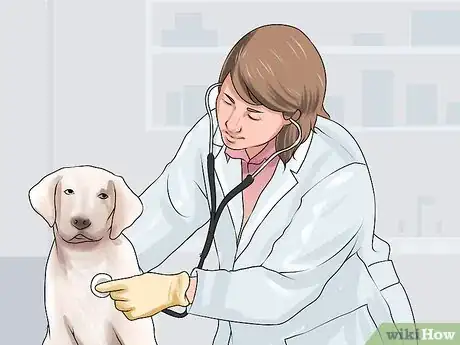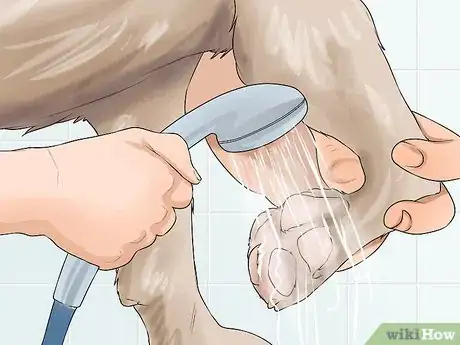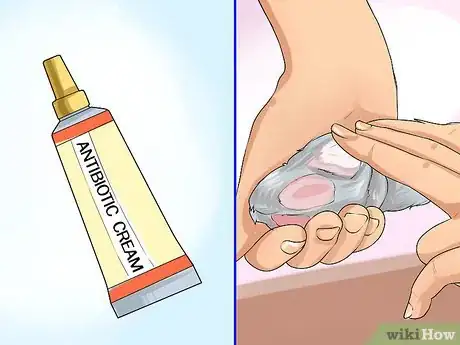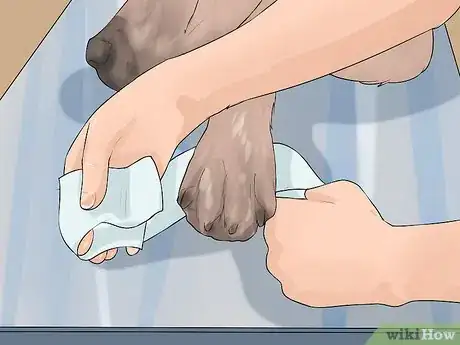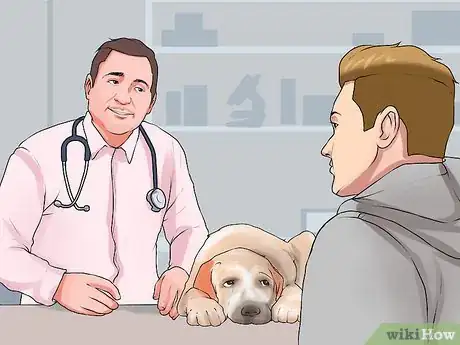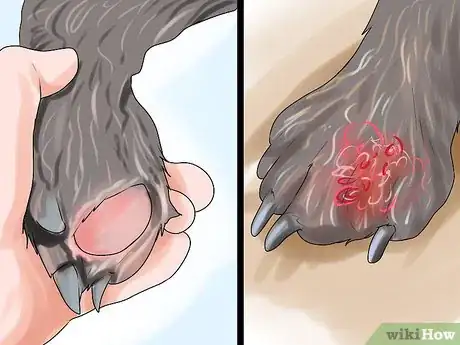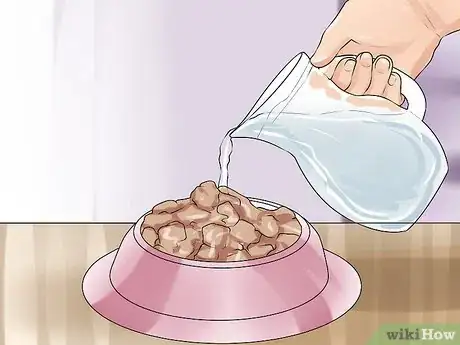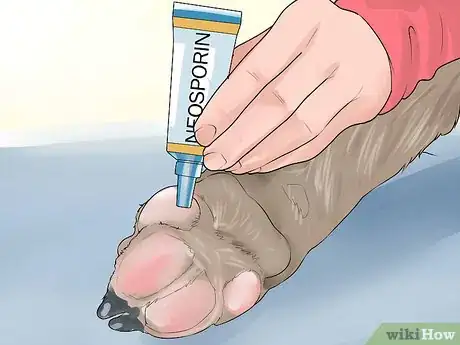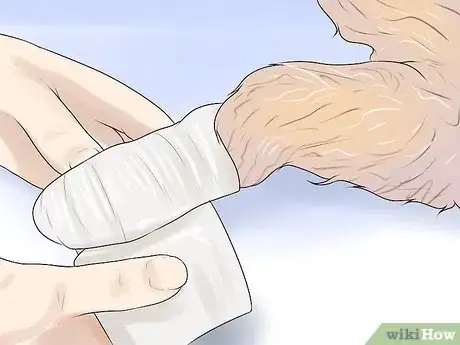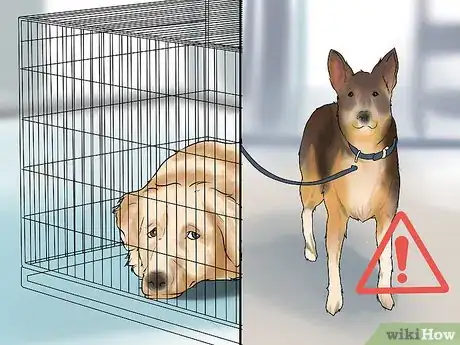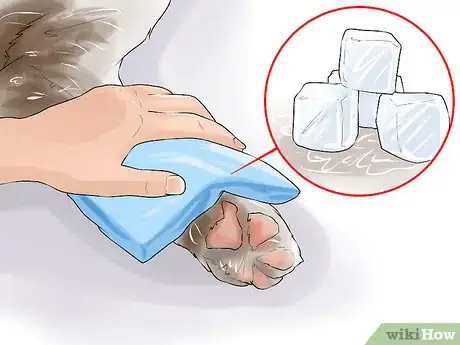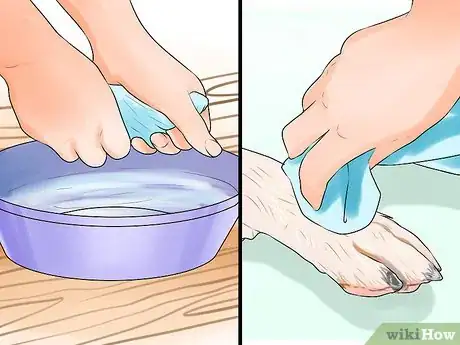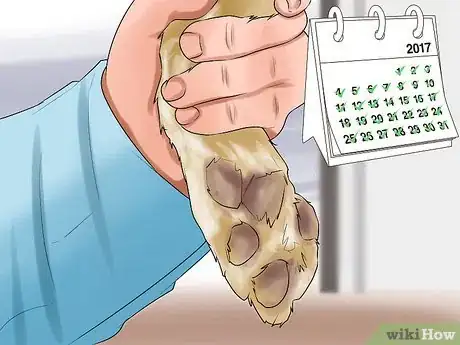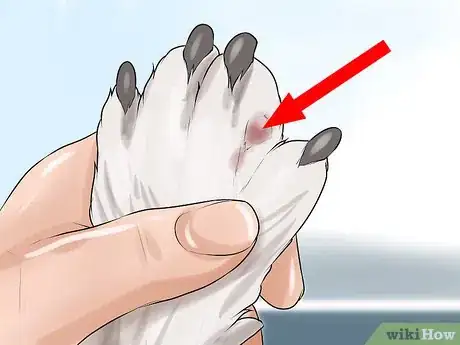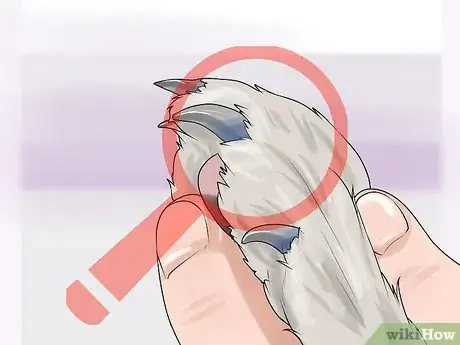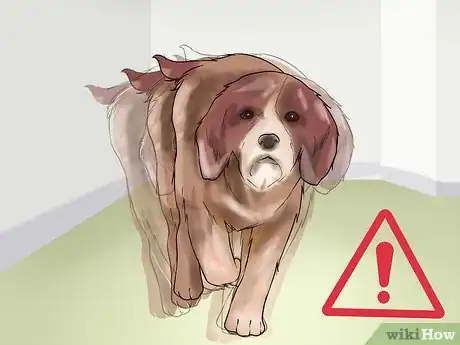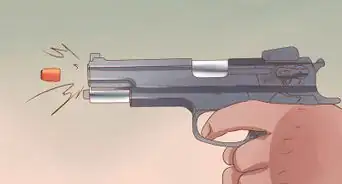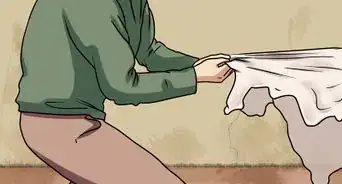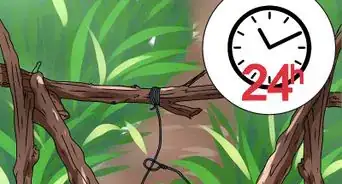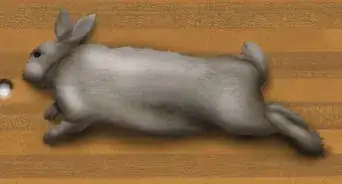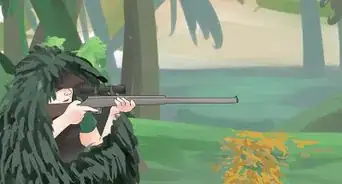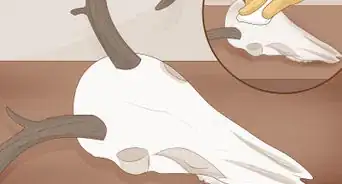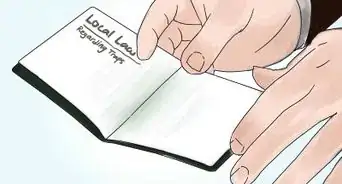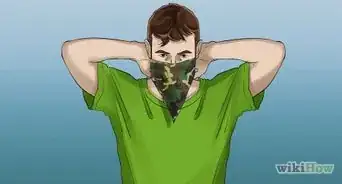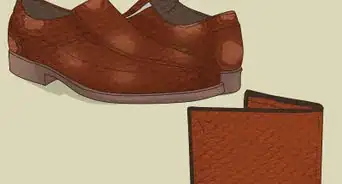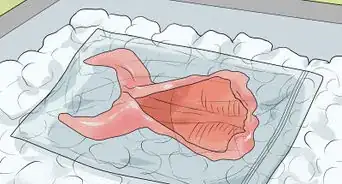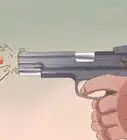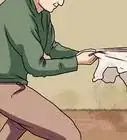This article was co-authored by Melissa Nelson, DVM, PhD. Dr. Nelson is a Veterinarian who specializes in Companion and Large Animal Medicine in Minnesota, where she has over 18 years of experience as a veterinarian in a rural clinic. She received her Doctor of Veterinary Medicine from the University of Minnesota in 1998.
There are 9 references cited in this article, which can be found at the bottom of the page.
This article has been viewed 23,269 times.
Hunting dogs’ paws are especially susceptible to injury since they spend a good amount of time outdoors and walking through tough conditions, like rocky terrain, brush, and wooded areas. You can help catch any injuries to your dog’s feet quickly by checking them before it goes outside and after it comes back in. If your dog does sustain an injury to its foot or paw pad, making sure it gets plenty of rest and treating the injury correctly can help get your dog back on its feet in no time.
Steps
Resting Your Dog
-
1Get a splint for your dog’s foot. You can help your dog heal more quickly from any kind of foot wound by limiting its activity for at least five to seven days after its injury. Get a splint for your dog’s foot to keep the pad from touching the ground and to keep weight off the pad. This can help abrasions and bruises heal more quickly.[1]
- If your dog chews on the splint to get it off, you may need to put a cone around its neck.
- Check on the splint twice a day to make sure it isn't wet or too tight.
-
2Walk your dog on a leash. Until the foot has fully recovered, you should only take your dog on leash walks. Doing so will allow you to control what your dog is walking on, how long it is walking, and the pace at which it is walking. Limiting these things can help cut down on the likelihood that your dog will reinjure its foot before it is completely healed.[2]Advertisement
-
3Keep your dog in its crate. It may also be necessary to keep your dog in its crate for the majority of the day while it is healing. Doing so will restrict its movement and keep it off its feet more than if it is allowed to go anywhere in the house. Again, do this for about five to seven days after the injury.
- Make sure your dog has plenty of toys to play with in its crate, as well as access to fresh water at all times.
- If your dog loves attention, place its crate in a high traffic area of the house. If your dog is shy or nervous, however, placing its crate in a quiet room might be better.
- If you are crating your dog during the day when no one is home, you can make your dog feel more comfortable by leaving a radio playing softly or leaving the TV on while you are away.[3]
- Don’t leave your dog in its crate for too long at one time. If possible, allow your dog to leave the crate every few hours. When it’s not in its crate, you can keep your dog from walking too much by using baby gates or closing doors to limit its access to just one or two rooms.[4]
- Make sure you put blankets and pillows in the crate so your dog is comfortable.
-
4Take your dog to the vet. Many paw pad injuries will heal significantly with rest. However, if your dog’s injury doesn’t seem to be getting better with rest and you’re not comfortable trying to treat the dog’s injuries yourself, take your dog to the vet. The vet can diagnose your dog’s injury and take care of the initial treatment.
Treating Minor Cuts and Puncture Wounds
-
1Remove the foreign object. If your dog’s paw pad has been punctured by a foreign object, like a piece of glass, rock, or thorn, remove the object before treating the wound. To remove the object, grasp it firmly with your fingers or a pair of tweezers, and pull it out quickly. Try to pull the object straight out to avoid causing any more damage to the pad.[5]
- Foxtail punctures are a particularly common injury in hunting dogs. Foxtails are arrow-shaped, pointed weeds that grow outdoors. These can become lodged in between your dog’s toes or in the pad of its foot and cause great discomfort or an abscess. Do your best to avoid walking your dog through foxtails while you are hunting.[6]
-
2Wash your dog’s paw. Once the foreign object has been removed, wash your dog’s paw with an antibacterial soap, paying special attention to the affected area. Be sure you wash the affected area thoroughly, even if it seems like it is making your dog uncomfortable.[7]
- Nolvasan or Betadine are two good antibacterial soaps you can use on your dog.[8]
-
3Apply antibiotic cream. Once you have washed the foot well, apply an antibiotic cream to the cut or abrasion. Rub the cream into the area well so that your dog cannot lick it off.[9]
- If your dog is licking incessantly at the cream, despite rubbing it in, it might help to get a cone to put around your dog’s head. This will prevent it from being able to lick its feet.
-
4Wrap your dog’s paw. It is also a good idea to wrap your dog’s paw after you apply the antibiotic cream. This will help prevent your dog from licking the antibiotic cream off and further irritating the injury. To wrap your dog’s foot, loosely wrap clean gauze from the joint around your dog’s ankle down around the pad of its foot, and then back up the leg. You can apply white tape wrap over the bandage to help ensure it stays in place.
- Be careful not to wrap the bandage too tight. If you do, your dog’s leg will swell. If you notice swelling, unwrap the bandage and rewrap it so it is not as tight on your dog’s leg.[10]
-
5Take your dog to the vet. You should take your dog to the vet for any puncture wound, as these can cause damage underneath the pad as well. In addition, if you have treated your dog’s cut or abrasion as recommended, but it does not improve within a few days or your dog is still limping or favoring one leg, take your dog to the vet to ensure there is not a bigger problem.[11]
Treating Cracked or Irritated Paw Pads
-
1Take your dog to the vet. There can be numerous causes of cracked or irritated paw pads, so you should take your dog to the vet if you notice it has this type of injury. Your vet can help you determine the cause of the irritation by first ruling out any health disorders, like allergies, and can recommend the best way to treat it.
- If it is determined that the drying and cracking is due to contact irritants or food allergies, you should do your best to avoid walking your dog through these irritants and remove the items your dog is allergic to from its diet.[12]
-
2Soak your dog’s foot in warm water. If you’ve determined your dog’s cracked paw pads are not the result of a larger health problem, you can treat them at home. Antibacterial creams and ointments are better absorbed after soaking your dog’s foot in warm water for a few minutes. To do so, fill a small tub with warm water and completely submerge the affected foot or feet for several minutes.[13]
-
3Apply softening or antibacterial ointments. After soaking your dog’s foot, apply ointments like Vaseline or Neosporin to help soften the pad and keep away infection. Make sure you apply the ointment to the entire pad and rub it in well.[14]
-
4Place a sock or bandage on your dog’s foot. To keep your dog from licking off the ointment, place a clean sock or bandage on your dog’s foot after you’ve applied the cream. You can use gauze to bandage the foot from the joint above your dog’s ankle, down and around the entire paw pad, and back up the leg.
- Keep the sock or bandage on for several hours so the ointment can be absorbed into your dog’s paw pads. Continue to do this until your dog’s pads are back to normal and no longer cracked or excessively dry.[15]
Treating a Bruised Paw Pad
-
1Keep your dog off its feet. Most bruises will heal on their own within five to seven days. You can help expedite this process by keeping your dog off its feet as much as possible during this time. Limit its time outside its crate and keep it on a leash if it needs to go outside.
-
2Ice your dog’s paw pad. Apply ice to the affected area at least once a day for no more than 10 minutes at a time. Doing this will help the broken blood vessels constrict, which can help to expedite the healing process.[16]
- Wrap the ice pack or bag of ice in a towel before holding it to your dog’s paw pad. An ice pack or bag of ice on its own may be too cold for your dog to bear.
-
3Hold a hot washcloth against the bruise. Applying heat to the bruised area can help reduce the pain your dog feels from the injury. It won’t necessarily help the bruise heal faster, however. Do this once a day, or as needed, until the area appears to be back to normal and your dog seems to no longer be in pain.[17]
- Test the hot washcloth on your skin first. If it is too hot to hold against your own skin for a few minutes, let it cool down before holding it against your dog’s paw.
Finding an Injury
-
1Inspect your dog’s paws daily. You can reduce the seriousness of a paw pad injury by checking your dog for any signs of an injury daily. You should examine your dog’s paws every time it comes in from the outside. In addition, check your dog’s paws for injuries before taking it out on a hunting trip. The type of injury your dog has will determine what kind of treatment it needs.[18]
- If you discover a bad injury, like puncture wounds or tears in your dog's paw pad, take your dog to the vet immediately.
-
2Look between your dog’s toes, on the top of its feet, and between its paw pads. When you are checking your dog’s feet for injuries, make sure you check the entire foot closely, looking for any red, irritated areas, lacerations, objects stuck in its feet or in between its toes and paw pads, and cracked or blistered paw pads.[19]
-
3Push firmly on your dog’s paw pads. In addition, push firmly on your dog’s paw pads to determine if your dog is feeling any discomfort that is not visible. Discomfort when you do this can indicate your dog has a bruised paw pad. It can also indicate a puncture wound that is covered over and infected. If the pad feels hot or your dog has a temperature, this may be an infection, not a bruise.[20]
-
4Inspect your dog’s nails. Also check your dog’s nails for any signs of infection. Look carefully to identify any discoloration in the nails (like a white nail with a brown center), and swelling or redness where the nail goes into your dog’s toe.[21]
-
5Watch for limping. If your dog is limping, this is a good indication it has some kind of injury. If you notice your dog is not using one of its legs, or is using it very gingerly, inspect that leg, including the paw and paw pads.[22]
-
6Watch for excessive licking or chewing of the paws. Another indication that your dog may have a paw pad injury is if it is licking, chewing, or biting at its paws more than normal. If you notice your dog doing this, give it a thorough examination of its paws.[23]
Warnings
- Although many injuries to your dog’s paw pads can be treated at home, it is always a good idea to make an appointment with the veterinarian, just in case. If you treat your dog’s injury at home and it is not showing improvement after several days, take it to the vet to ensure there is not a bigger underlying problem.⧼thumbs_response⧽
References
- ↑ http://www.gundogsonline.com/Article/reducing-paw-pad-injuries-in-athletic-dogs-Page2.htm
- ↑ http://nypost.com/2015/01/17/how-to-get-your-pet-back-on-four-legs-after-an-injury/
- ↑ http://www.vetstreet.com/care/dog-limping-how-to-get-your-dog-back-on-his-feet
- ↑ http://www.humanesociety.org/animals/dogs/tips/crate_training.html?referrer=https://www.google.com/
- ↑ https://www.outsideonline.com/1905191/10-most-common-dog-ailments-and-how-treat-them-field
- ↑ http://www.akcchf.org/canine-health/your-dogs-health/caring-for-your-dog/keeping-dogs-paws-healthy.html
- ↑ http://www.akcchf.org/canine-health/your-dogs-health/caring-for-your-dog/keeping-dogs-paws-healthy.html
- ↑ http://www.gundogsonline.com/Article/reducing-paw-pad-injuries-in-athletic-dogs-Page2.htm
- ↑ http://www.akcchf.org/canine-health/your-dogs-health/caring-for-your-dog/keeping-dogs-paws-healthy.html
- ↑ https://www.outsideonline.com/1905191/10-most-common-dog-ailments-and-how-treat-them-field
- ↑ http://www.gundogsonline.com/Article/reducing-paw-pad-injuries-in-athletic-dogs-Page2.htm
- ↑ https://pethelpful.com/dogs/Causes-of-Cracked-Paw-Pads-in-Dogs
- ↑ https://pethelpful.com/dogs/Causes-of-Cracked-Paw-Pads-in-Dogs
- ↑ https://pethelpful.com/dogs/Causes-of-Cracked-Paw-Pads-in-Dogs
- ↑ https://pethelpful.com/dogs/Causes-of-Cracked-Paw-Pads-in-Dogs
- ↑ https://www.cuteness.com/article/bruise-dogs-paw
- ↑ https://www.cuteness.com/article/bruise-dogs-paw
- ↑ http://www.akcchf.org/canine-health/your-dogs-health/caring-for-your-dog/keeping-dogs-paws-healthy.html
- ↑ http://www.akcchf.org/canine-health/your-dogs-health/caring-for-your-dog/keeping-dogs-paws-healthy.html
- ↑ http://www.gundogsonline.com/Article/reducing-paw-pad-injuries-in-athletic-dogs-Page1.htm
- ↑ http://www.gundogsonline.com/Article/reducing-paw-pad-injuries-in-athletic-dogs-Page1.htm
- ↑ http://www.akcchf.org/canine-health/your-dogs-health/caring-for-your-dog/keeping-dogs-paws-healthy.html
- ↑ http://www.akcchf.org/canine-health/your-dogs-health/caring-for-your-dog/keeping-dogs-paws-healthy.html
